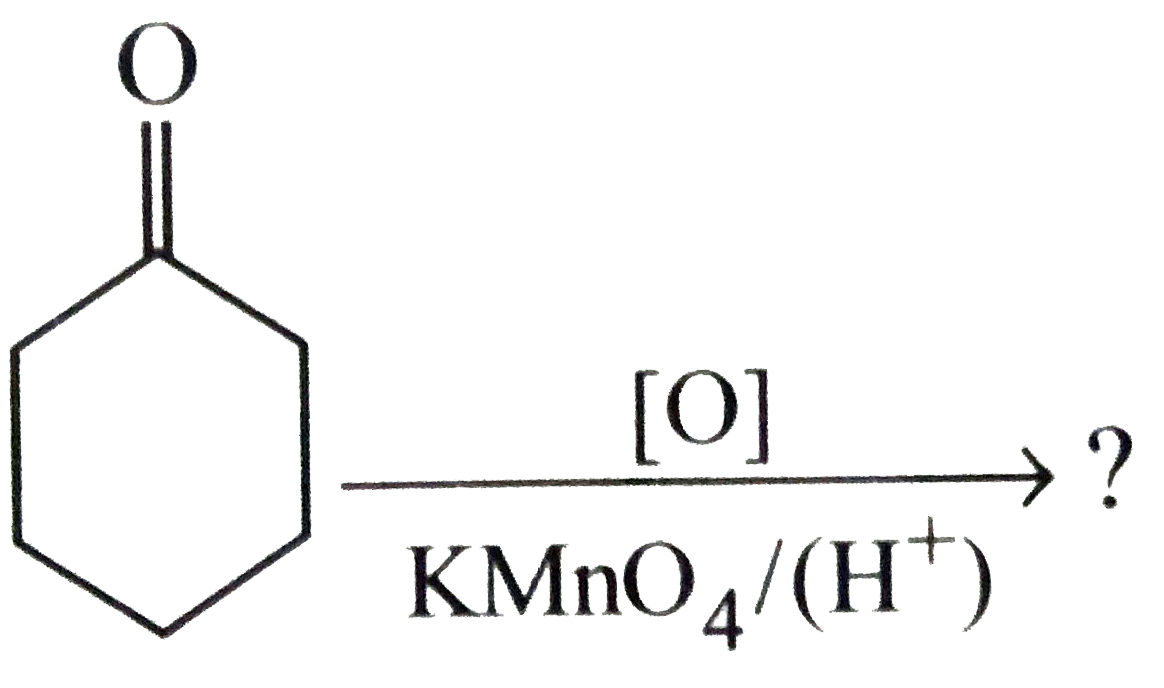Complete Solutions to PASSAGE 2 of chapter ALDEHYDES AND KETONES of Class 12 book with complete answers and questions
| Class 12 | CHEMISTRY |
| Chapter | ALDEHYDES AND KETONES |
| OP TANDON | PASSAGE 2 |
| Number Of Questions | 5 |
| Academic Year | 2023-24 |
Carbonyl compounds give different oxidation products with different reagents. Several oxidising agents can be used to oxides carbonyl compound. Ammonical silver nitrate (Tollens' reagent) oxidises aliphitic as well as aromatic aldehydes.
`R-CHOoverset("Tollenes reagent ")rarrR-COOH+Ag("Silver mirror")`
Strong oxidising agents like `KMnO_(4)//H^(+),HNO_(3) K_(2)Cr_(2)O_(7)//H^(+)` oxidise aldehydes as well as ketones. Open chain ketnoes on oxidation give mixture of two carboxylic acids. Oxidation of unsymmetrical ketones takes place acording to Popoff's rule. According to this rule, `alpha` whose bond breks in oxidation always belongs to the alkyl group which has more number of carbons.
Tollens' reagent gives positive test with :
View SolutionCarbonyl compounds give different oxidation products with different reagents. Several oxidising agents can be used to oxides carbonyl compound. Ammonical silver nitrate (Tollens' reagent) oxidises aliphitic as well as aromatic aldehydes.
`R-CHOoverset("Tollenes reagent ")rarrR-COOH+Ag("Silver mirror")`
Strong oxidising agents like `KMnO_(4)//H^(+),HNO_(3) K_(2)Cr_(2)O_(7)//H^(+)` oxidise aldehydes as well as ketones. Open chain ketnoes on oxidation give mixture of two carboxylic acids. Oxidation of unsymmetrical ketones takes place acording to Popoff's rule. According to this rule, `alpha` whose bond breks in oxidation always belongs to the alkyl group which has more number of carbons.
The reagent which oxidises only aliphatic ketones is :
View SolutionCarbonyl compounds give different oxidation products with different reagents. Several oxidising agents can be used to oxides carbonyl compound. Ammonical silver nitrate (Tollens' reagent) oxidises aliphitic as well as aromatic aldehydes.
`R-CHOoverset("Tollenes reagent ")rarrR-COOH+Ag("Silver mirror")`
Strong oxidising agents like `KMnO_(4)//H^(+),HNO_(3) K_(2)Cr_(2)O_(7)//H^(+)` oxidise aldehydes as well as ketones. Open chain ketnoes on oxidation give mixture of two carboxylic acids. Oxidation of unsymmetrical ketones takes place acording to Popoff's rule. According to this rule, `alpha` whose bond breks in oxidation always belongs to the alkyl group which has more number of carbons.
The prduct of given reaction is
is
View SolutionCarbonyl compounds give different oxidation products with different reagents. Several oxidising agents can be used to oxides carbonyl compound. Ammonical silver nitrate (Tollens' reagent) oxidises aliphitic as well as aromatic aldehydes.
`R-CHOoverset("Tollenes reagent ")rarrR-COOH+Ag("Silver mirror")`
Strong oxidising agents like `KMnO_(4)//H^(+),HNO_(3) K_(2)Cr_(2)O_(7)//H^(+)` oxidise aldehydes as well as ketones. Open chain ketnoes on oxidation give mixture of two carboxylic acids. Oxidation of unsymmetrical ketones takes place acording to Popoff's rule. According to this rule, `alpha` whose bond breks in oxidation always belongs to the alkyl group which has more number of carbons.
2-Methylcycolhexanone on oxidation will give :
View SolutionCarbonyl compounds give different oxidation products with different reagents. Several oxidising agents can be used to oxides carbonyl compound. Ammonical silver nitrate (Tollens' reagent) oxidises aliphitic as well as aromatic aldehydes.
`R-CHOoverset("Tollenes reagent ")rarrR-COOH+Ag("Silver mirror")`
Strong oxidising agents like `KMnO_(4)//H^(+),HNO_(3) K_(2)Cr_(2)O_(7)//H^(+)` oxidise aldehydes as well as ketones. Open chain ketnoes on oxidation give mixture of two carboxylic acids. Oxidation of unsymmetrical ketones takes place acording to Popoff's rule. According to this rule, `alpha` whose bond breks in oxidation always belongs to the alkyl group which has more number of carbons.
Which of the following ismost reactive towards oxidation ?
View Solution
PASSAGE 2 questions and complete solutions for chapter ALDEHYDES AND KETONES of G.R. BATHLA & SONS CHEMISTRY (HINGLISH) of Class 12
All Exercises from OP TANDON Class 12 CHEMISTRY ALDEHYDES AND KETONES
- ASSERTION-REASON TYPE QUESTIONS
- BRAIN STORMIN PROBLEMS
- ILLUSTRATIONS OF OBJECTIVE QUESTIONS
- MATCHING TYPE
- MATRIX-MATCH TYPE QUESTIONS
- OBJECTIVE QUESTIONS (LEVEL -A)
- OBJECTIVE QUESTIONS (LEVEL -B) SET I
- OBJECTIVE QUESTIONS (LEVEL -B) SET II
- PASSAGE 1
- PASSAGE 2
- PASSAGE 3
- PASSAGE 4
- PASSAGE 5
- PASSAGE 6
- PASSAGE 7
- PASSAGE 8
- PROBLEMS BASED ON STRUCTURE AND PROPETIES
- PROBLEMS FOR PRACTICE
- SINGLE INTEGER ANSWER TYPE QUESTIONS
- SOME SOLVED PROBLEMS